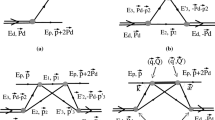Summary
We present a discussion of the energy-dependent behaviour of the proton-deuteron elastic scattering atϑ c.m.=180°. We show that the interference betweenS andP waves is mainly responsible for the low-energy peak. It is also pointed out that the present-day experimental information is not sufficient to support or rule out the alternative explanations for the higher-energy peak.
Riassunto
Si discute il comportamento dipendente dall’energia dello scattering elastico protonedeutone perϑ c.m.=180°. Si dimostra che il picco di bassa energia è determinato principalmente dall’interferenza tra ondeS eP. Inoltre si pone in evidenza che gli attuali dati sperimentali non sono sufficienti per sostenere o scartare le alternative interpretazioni proposte per il picco di alta energia.
Реэюме
Мы обсуждаем знергетическую эависимость упругого рассеяния про-тона на дейтроне наθ Ц.М.=180°. Мы покаэываем, что интерференция междуS иP волнами в основном ответственна эа пик при ниэких знергиях. Также отмечается, что имеюшаяся на сегоднящний день зкспериментальная информация недостаточна для подтверждения или исключения альтернативных общяснений для пика при высо-ких знергиях.
Similar content being viewed by others
References
B. S. Bhakar andV. S. Bhasin: inFew Particle Problems in the Nuclear Interaction, edited byI. Slaus, S. A. Moszkowski, R. P. Haddock andW. T. H. van Oers (Amsterdam, 1972), p. 523.
A. Horsley:Nucl. Data, A4, 321 (1968).
J. D. Seagrave: inThree-Particle Problems in the Nuclear and Particle Physics, edited byJ. S. McKee andP. M. Rolph (Amsterdam, 1970), p. 41.
Particle Data Group: University of California, Report No. UCRL-20000NN.
G. Igo, J. C. Fong, S. L. Verbeck, M. Goitein, D. L. Hendrie, J. C. Carroll, B. McDonald, A. Stetz andM. C. Makino:Nucl. Phys.,195 A, 33 (1972).
J. C. Alder, W. Dollhoff, C. Lunke, C. F. Perdrisat, W. K. Roberts, P. Kitching, G. Moss, W. C. Olsen andJ. R. Priest:Phys. Rev. C,6, 2010 (1972).
Y. Yamaguchi:Phys. Rev.,95, 1635 (1954).
A. N. Mitra: inAdvances in Nuclear Physics, edited byM. Baranger andE. Vogt, Vol.3 (New York, 1969), p. 1;I. H. Sloan:Nucl. Phys.,168 A, 211 (1971).
J. S. Sharma, V. S. Bhasin andA. N. Mitra:Nucl. Phys.,35 B, 466 (1971). (There are several errors in this paper.)
A. K. Kerman andL. S. Kisslinger:Phys. Rev.,180, 1483 (1969).
N. S. Craigie andC. Wilkin:Nucl. Phys.,14 B, 477 (1969). There are several errors in this paper. See alsoG. W. Barry:Ann. of Phys.,73, 482 (1972);Phys. Rev. D,7, 1441 (1973).
H. L. Anderson, M. S. Dixit, H. J. Evans, K. A. Klare, D. A. Larson, M. V. Sherbrook, R. L. Martin, D. Kessler, D. B. Nagle, H. A. Thiesseu, C. K. Hargrove, B. P. Hincks andS. Fukui:Phys. Rev. D,3, 1536 (1971).
J. Chahoud, G. Russo andF. Selleri:Phys. Rev. Lett.,11, 506 (1963). The arguments presented in this paper are also applicable to the pd→dp scattering as both pp→dπ+ and pn→dπ0 contribute to the triangular graphc) of Fig. 2. Effect of pn→dπ0 is taken care of by the factor 3/2 in eq. (3).
Such a hypothesis was first advanced byV. A. Grishin andM. J. Podgoretskii: JINR-Report No. R-1508, Dubna (1964). See alsoL. A. Kondratyuk andI. S. Shapiro:Yad. Fiz.,12, 401 (1971) (Sov. Journ. Nucl. Phys.,12, 220 (1970).)
The indications are that the force between nucleon and Δ(1236) is strong enough to give rise to a dibaryon resonance in the (J p=2+,T=1) state. (The present situation for the existence of dibaryon resonances is reviewed byL. M. Libby andE. Predazzi:Lett. Nuovo Cimento,2, 881 (1969).) Therefore, it is appropriate to take the Δ(1236), instead of theN *(1688)-resonance, for the formation of the 3Δ He-state.
Author information
Authors and Affiliations
Additional information
To speed up publication, the author of this paper has agreed to not receive the proofs for correction.
This work was supported by a grant from the National Research Council of Canada.
Rights and permissions
About this article
Cite this article
Bhakar, B.S. The behaviour of large-angle pd → dp scattering with energy. Nuov Cim A 18, 737–746 (1973). https://doi.org/10.1007/BF02727589
Received:
Published:
Issue Date:
DOI: https://doi.org/10.1007/BF02727589




